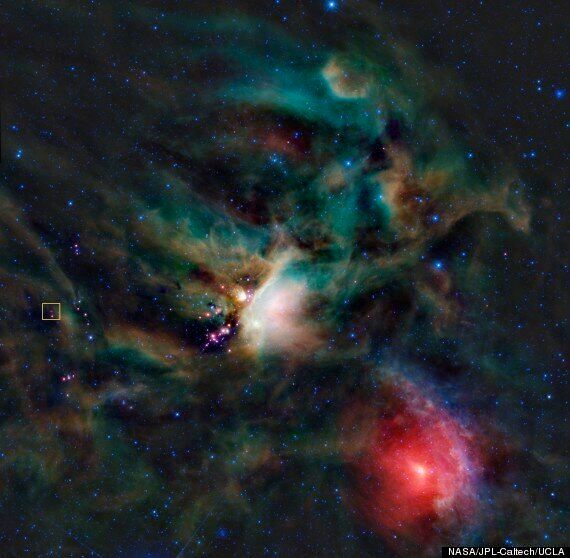Many astronomers believe that given how many stars there are – roughly a septillion - and how old the universe is - 14 billion years - it’s not likely that we’re alone.
Now that notion has even more weight to it, because scientists have, for the first time, discovered building blocks of life swirling around a nearby star.
Obviously this isn’t quite ‘first contact’ – but it’s a start.

The young star, marked with a yellow square, lies in a star-forming region called Rho Ophiuchi, which measures around 14 light years across
Life is made up of a series of complex organic molecules, including sugars – and a team of astronomers led by researchers from the Niels Bohr Institute in Copenhagen, Denmark, have observed a simple sugar molecule consisting of carbon, oxygen and hydrogen atoms in the gas surrounding a young star.
In addition to the sugar molecules the researchers also saw signs of a number of other complex organic molecules, including ethylene-glycol, methyl-formate and ethanol.
What’s more, the star is a neighbour, cosmically speaking, as it’s only 400 light years away, in the Rho Ophiuchi star forming region.
Speaking about the discovery, astrophysicist Jes Jørgensen, Associate Professor at the institute, said: “This could potentially tell us something about the possibility that life might arise elsewhere and whether precursors to biology are already present before the planets have been formed.”
Dr Jørgensen explained that the quantity of sugar found was significant.
He told The Huffington Post UK: "If we sum up the number of molecules there is a total mass of one quintillion, or one billion billion metric tons of glycolaldehyde there.
"However, this is just a small fraction of the total gas and dust around the star: if we were going to take one cubic centimetre of the gas around the young star - about the size of a regular dice - it would consist of maybe a billion molecules out of which only a handful would be glycolaldehyde. In percentage terms that's a millionth of a percent, or 0.000001%. But from an astronomical point of view it is still a significant abundance."

The sugar-hunting telescopes in Chile
The star was observed with the new large international telescope, Atacama Large Millimeter Array (ALMA) in northern Chile.
The ALMA telescopes are able to zoom in and study the details of newly formed stars and their rotating discs of dust and gas, which subsequently clumps together and forms planets.
Among other things, the astronomers would like to investigate the gas for the presence of water vapour and examine the chemical composition for complex molecules.
"In the protoplanetary disc of gas and dust surrounding the young, newly formed star, we found glycolaldehyde molecules, which are a simple form of sugar. It is one of the building blocks in the process that leads to the formation of RNA and the first step in the direction of biology," explained Jørgensen.
He explained that at first the gas and dust cloud is extremely cold - only around 10 degrees above absolute zero at minus 273C - and simple gases such as carbon monoxide and methane settle on particles of dust and solidify as ice.
Here on the particles of dust, the otherwise volatile gases come close to each other and can bond together and form more complex molecules.
When the star has been formed in the middle of the gas and dust cloud, it emits heat, and the inner parts of the rotating cloud surrounding the star is heated to around room temperature, after which the chemically complex molecules on the particles of dust evaporate as gas.
This gas emits radiation as radio waves at low frequencies and it is this radiation that researchers can observe with the ALMA telescopes.
The results have been published in the scientific journal Astrophysical Journal Letters.